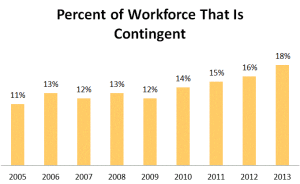 What does a contingent worker look like? This was a question I posed during CFO magazine’s webcast, “The CFO Playbook on Human Capital – The War for Talent: How to Better Recruit and Retain the Best and the Brightest.” I sat on a panel with a distinguished group of executives who explored the changing role of CFOs and the finance professionals who support them, as well as the strategies organizations can employ to win the war for talent. While the panelists offered outstanding insights into the CFO’s transformation to a more strategic and analytical role, as well as the new, broader set of skills finance professionals need to succeed in highly competitive global markets, they focused exclusively on the traditional “employed” workforce. My perspective, as you might guess, centered on the best and brightest in the contingent workforce and ways they can — and do — play an increasingly significant role in addressing the critical talent challenges organizations face today.
What does a contingent worker look like? This was a question I posed during CFO magazine’s webcast, “The CFO Playbook on Human Capital – The War for Talent: How to Better Recruit and Retain the Best and the Brightest.” I sat on a panel with a distinguished group of executives who explored the changing role of CFOs and the finance professionals who support them, as well as the strategies organizations can employ to win the war for talent. While the panelists offered outstanding insights into the CFO’s transformation to a more strategic and analytical role, as well as the new, broader set of skills finance professionals need to succeed in highly competitive global markets, they focused exclusively on the traditional “employed” workforce. My perspective, as you might guess, centered on the best and brightest in the contingent workforce and ways they can — and do — play an increasingly significant role in addressing the critical talent challenges organizations face today.
The Transformative Role of the CFO
The role of the CFO is definitely changing. The CFO now functions as a chief analytics officer. To capitalize on the proliferation of big data, CFOs need a team of finance professionals who not only collect and report data but analyze and synthesize insights from it. Rather than simply documenting facts and figures, they need to participate more proactively in business operations. With this broader slate of responsibilities, executives are questioning how they will get the work done. Where will they find the talent they need and how will they retain it?
PREMIUM CONTENT: Webinar replay: Creative Management Strategies for the Contingent Workforce
 A New Strategy in the War for Talent
A New Strategy in the War for Talent
One way to address talent challenges is to more effectively leverage a workforce that is already working for you — the contingent workforce. While many companies completely ignore this growing pool of talent, those that leverage it effectively are competing and winning. According to the Staffing Industry Analysts 2013 Contingent Buyer Survey, respondents say their use of contingent workers continues to rise, from an average of 12 percent in 2009 to 18 percent in 2013. In some companies, the use of contingent workers is substantially higher. In fact, I recently met with a Fortune 500 company whose CEO wants a workforce that is balanced 50/50 between traditional employees and contingent workers. This is clear acknowledgment of the strategic value the contingent workforce can deliver.
Capitalizing on Contingent Workforce Value
Leveraging the contingent workforce requires visibility, the kind the “new” CFO thrives upon. As the steward of business intelligence, the new CFO has an opportunity to harness the big data that exists in non-employee talent pools. Who are these people, what are their skills, how are they performing, what is the best way to deploy them? Are they in core or non-core roles? Are they adding capabilities not native to the organization or backfilling required functions to free up internal talent for more strategic tasks? The answers can help you build a human capital engine that is more flexible, cost effective and nimble.
So What Do Contingent Workers Look Like?
Going back to the question I posed earlier, can you tell employees from non-employees in the picture? The answer is: it doesn’t matter. From a collaboration and cultural integration perspective, think of contingent workers in much the same way as you view your employees. Further, you should take steps to ensure their success by doing the same types of things you do with your employees: onboard them seamlessly, set them up to be productive ASAP, establish clear goals and expectations, communicate frequently, help them understand how they fit into the bigger team and why their work — short term or long term — matters to the organization’s future.
Contractors and freelancers often have skills that your own employees don’t. That means you need them more than they need you. Companies that make it easy for contingent workers to engage will win the war for talent. Is your organization leveraging non-employee talent or is it an untapped gold mine waiting to be engaged?









[…] David W. Barfield, CEO First Seen on The Staffing Stream […]